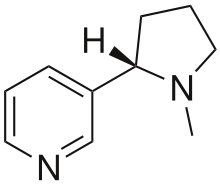
Nicotine

Nicotine is a stimulant and potent parasympathomimetic alkaloid that is naturally produced in the nightshade family of plants. It is used for the treatment of tobacco use disorders as a smoking cessation aid and nicotine dependence for the relief of withdrawal symptoms. Nicotine acts as a receptor agonist at most nicotinic acetylcholine receptors (nAChRs), except at two nicotinic receptor subunits (nAChRα9 and nAChRα10) where it acts as a receptor antagonist. Nicotine constitutes approximately 0.6–3.0% of the dry weight of tobacco. Usually consistent concentrations of nicotine varying from 2–7 µg/kg (20–70 millionths of a percent wet weight) are found in the edible family Solanaceae, such as potatoes, tomatoes, and eggplant. Some research indicates that the contribution of nicotine obtained from food is substantial in comparison to inhalation of second-hand smoke. Others consider nicotine obtained from food to be trivial unless exceedingly high amounts of certain vegetables are eaten. It functions as an antiherbivore chemical; consequently, nicotine was widely used as an insecticide in the past, and neonicotinoids, such as imidacloprid, are widely used. Nicotine is highly addictive. It is one of the most commonly abused drugs. An average cigarette yields about 2 mg of absorbed nicotine; high amounts can be more harmful. Nicotine addiction involves drug-reinforced behavior, compulsive use, and relapse following abstinence. Nicotine dependence involves tolerance, sensitization, physical dependence, and psychological dependence. Nicotine dependence causes distress. Nicotine withdrawal symptoms include depressed mood, stress, anxiety, irritability, difficulty concentrating, and sleep disturbances. Mild nicotine withdrawal symptoms are measurable in unrestricted smokers, who experience normal moods only as their blood nicotine levels peak, with each cigarette. On quitting, withdrawal symptoms worsen sharply, then gradually improve to a normal state. Nicotine use as a tool for quitting smoking has a good safety history. Nicotine itself is associated with some health concerns. Youth are especially sensitive to the effects of nicotine. Nicotine is potentially harmful to non-users. At low amounts, it has a mild analgesic effect. The International Agency for Research on Cancer indicates that nicotine does not cause cancer. Nicotine has been shown to produce birth defects in some animal species, but not others; consequently, it is considered to be a possible teratogen in humans. The median lethal dose of nicotine in humans is unknown, but high doses are known to cause nicotine poisoning. The primary therapeutic use of nicotine is treating nicotine dependence to eliminate smoking and the damage it does to health. Controlled levels of nicotine are given to patients through gums, dermal patches, lozenges, inhalers, electronic/substitute cigarettes or nasal sprays to wean them off their dependence. A 2018 Cochrane Collaboration review found high quality evidence that all current forms of nicotine replacement therapy (gum, patch, lozenges, inhaler, and nasal spray) therapies increase the chances of successfully quitting smoking by 50–60%, regardless of setting. Combining nicotine patch use with a faster acting nicotine replacement, like gum or spray, improves the odds of treatment success. 4 mg versus 2 mg nicotine gum also increase the chances of success. In contrast to recreational nicotine products, which have been designed to maximize the likelihood of addiction, nicotine replacement products (NRTs) are designed to minimize addictiveness.:112 The more quickly a dose of nicotine is delivered and absorbed, the higher the addiction risk. Nicotine has been used as an insecticide since at least the 1690s, in the form of tobacco extracts (although other components of tobacco also seem to have pesticide effects). Nicotine pesticides have not been commercially available in the US since 2014, and homemade pesticides are banned on organic crops and counterrecommended for small gardeners. Nicotine pesticides have been banned in the EU since 2009. Foods are imported from countries in which nicotine pesticides are allowed, such as China, but foods may not exceed maximum nicotine levels. Neonicotinoids, which are derived from and structurally similar to nicotine, are widely used as agricultural and veterinary pesticides as of 2016.
